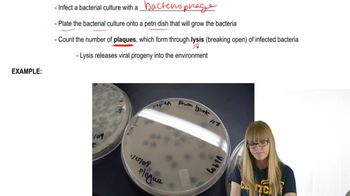Table of contents
- 1. Introduction to Genetics51m
- 2. Mendel's Laws of Inheritance3h 37m
- 3. Extensions to Mendelian Inheritance2h 41m
- 4. Genetic Mapping and Linkage2h 28m
- 5. Genetics of Bacteria and Viruses1h 21m
- 6. Chromosomal Variation1h 48m
- 7. DNA and Chromosome Structure56m
- 8. DNA Replication1h 10m
- 9. Mitosis and Meiosis1h 34m
- 10. Transcription1h 0m
- 11. Translation58m
- 12. Gene Regulation in Prokaryotes1h 19m
- 13. Gene Regulation in Eukaryotes44m
- 14. Genetic Control of Development44m
- 15. Genomes and Genomics1h 50m
- 16. Transposable Elements47m
- 17. Mutation, Repair, and Recombination1h 6m
- 18. Molecular Genetic Tools19m
- 19. Cancer Genetics29m
- 20. Quantitative Genetics1h 26m
- 21. Population Genetics50m
- 22. Evolutionary Genetics29m
18. Molecular Genetic Tools
Methods for Analyzing DNA
Problem 27
Textbook Question
Suppose you have a 1-kb segment of cloned DNA that is suspected to contain a eukaryotic promoter including a TATA box, a CAAT box, and an upstream GC-rich sequence. The clone also contains a gene whose transcript is readily detectable. Your laboratory supervisor asks you to outline an experiment that will (1) determine if eukaryotic transcription factors (TF) bind to the fragment and, if so, (2) identify where on the fragment the transcription factors bind. All necessary reagents, equipment, and experimental know-how are available in the laboratory. Your assignment is to propose techniques to be used to address the two items your supervisor has listed and to describe the kind of results that would indicate binding of TF to the DNA and the location of the binding. (Hint: The techniques and general results are discussed in this chapter.)
 Verified step by step guidance
Verified step by step guidance1
Step 1: To determine if eukaryotic transcription factors (TFs) bind to the DNA fragment, propose using an Electrophoretic Mobility Shift Assay (EMSA). This technique involves labeling the DNA fragment with a radioactive or fluorescent tag, incubating it with nuclear extracts containing TFs, and running the mixture on a non-denaturing polyacrylamide gel. If TFs bind to the DNA, the mobility of the DNA will decrease, resulting in a shifted band on the gel.
Step 2: To confirm the specificity of the binding observed in EMSA, perform a competition assay. Add an excess of unlabeled DNA (specific competitor) to the reaction. If the binding is specific, the labeled DNA-TF complex will be reduced or disappear. Additionally, use a non-specific competitor DNA to ensure that the binding is not due to non-specific interactions.
Step 3: To identify the specific regions of the DNA fragment where TFs bind, propose using DNase I footprinting. In this technique, the DNA fragment is labeled at one end, incubated with the nuclear extract, and treated with DNase I, which cleaves unprotected DNA. TF binding protects specific regions of the DNA from cleavage. The resulting DNA fragments are then separated on a denaturing polyacrylamide gel to visualize the protected regions (footprints).
Step 4: To further confirm the binding sites, propose using Chromatin Immunoprecipitation (ChIP) if the TFs are known. Crosslink the TFs to the DNA using formaldehyde, shear the DNA into smaller fragments, and use an antibody specific to the TF of interest to immunoprecipitate the DNA-TF complex. Reverse the crosslinks and analyze the DNA by PCR or sequencing to identify the binding sites.
Step 5: Interpret the results. For EMSA, a shifted band indicates TF binding, and competition assays confirm specificity. For DNase I footprinting, protected regions on the gel indicate TF binding sites. For ChIP, the presence of amplified DNA or sequencing reads corresponding to the promoter region confirms TF binding at specific sites.
 Verified video answer for a similar problem:
Verified video answer for a similar problem:This video solution was recommended by our tutors as helpful for the problem above
Video duration:
3mPlay a video:
Was this helpful?
Key Concepts
Here are the essential concepts you must grasp in order to answer the question correctly.
Eukaryotic Promoters
Eukaryotic promoters are specific DNA sequences located upstream of a gene that initiate transcription. They typically contain essential elements such as the TATA box, which is crucial for the binding of RNA polymerase and transcription factors. Other elements, like the CAAT box and GC-rich sequences, enhance the efficiency of transcription. Understanding these components is vital for designing experiments to study transcription factor binding.
Recommended video:
Guided course

Eukaryotic Transcription
Transcription Factors (TFs)
Transcription factors are proteins that bind to specific DNA sequences, regulating the transcription of genes. They can act as activators or repressors, influencing the recruitment of RNA polymerase to the promoter. Identifying the binding of TFs to DNA is essential for understanding gene expression regulation. Techniques such as electrophoretic mobility shift assays (EMSAs) or chromatin immunoprecipitation (ChIP) are commonly used to study these interactions.
Recommended video:
Guided course

Eukaryotic Transcription
Electrophoretic Mobility Shift Assay (EMSA)
EMSA is a technique used to study the binding of proteins, such as transcription factors, to DNA. In this assay, a labeled DNA fragment is mixed with protein extracts, and the resulting complexes are separated by gel electrophoresis. The shift in mobility of the DNA-protein complex compared to free DNA indicates binding. This method can also help identify the specific regions of DNA where transcription factors interact, providing insights into gene regulation.
Recommended video:
Guided course

Plaques and Experiments

 7:40m
7:40mWatch next
Master Methods for Analyzing DNA and RNA with a bite sized video explanation from Kylia
Start learningRelated Videos
Related Practice
Textbook Question
You have identified an enhancer trap line (see Figure 14.17) generated by P element transposition in Drosophila in which the marker gene from the enhancer trap is specifically expressed in the wing imaginal disc.How can you identify the gene adjacent to the insertion site of the enhancer trap?
410
views
